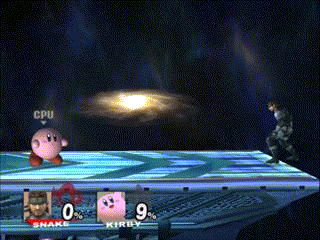Cross-up: Difference between revisions
mNo edit summary |
No edit summary |
||
| Line 1: | Line 1: | ||
{{ArticleIcons|allgames=y}} | {{ArticleIcons|allgames=y}} | ||
{{video|well the article talks shieldgrabs missing, so maybe the animation should have that?}} | |||
[[File:Brawl-Snake-DashAttack.gif|200px|right|thumb|Snake's dash attack used to perform a successful cross-up.]] | [[File:Brawl-Snake-DashAttack.gif|200px|right|thumb|Snake's dash attack used to perform a successful cross-up.]] | ||
A '''cross-up''' is the act of timing an attack (typically a [[dash attack]] or [[aerial]]) such that the user moves past the opponent and ends up behind them once the hitboxes are gone. Dash attacks are the more common kind of cross-up as the user is moving quickly already and many give the user additional propulsion. Cross-ups could be considered a kind of [[approach]], but they can also be used to perform [[mindgame]]s. The idea of the technique is that the attacker cannot be [[shield grab]]bed when behind the opponent, which makes such attacks safer to use by removing a common option from the defender. However, some characters have moves that strike faster against targets behind them (such as Kirby's up tilt or Mario's up smash), making the technique risky in such cases. Attacks that can be used to cross-up include {{SSBB|Snake}}'s dash attack and [[Fox Illusion]] - with proper [[spacing]], these attacks can put the user behind the opponent and end with the user in a less vulnerable position for punishment. | A '''cross-up''' is the act of timing an attack (typically a [[dash attack]] or [[aerial]]) such that the user moves past the opponent and ends up behind them once the hitboxes are gone. Dash attacks are the more common kind of cross-up as the user is moving quickly already and many give the user additional propulsion. Cross-ups could be considered a kind of [[approach]], but they can also be used to perform [[mindgame]]s. The idea of the technique is that the attacker cannot be [[shield grab]]bed when behind the opponent, which makes such attacks safer to use by removing a common option from the defender. However, some characters have moves that strike faster against targets behind them (such as Kirby's up tilt or Mario's up smash), making the technique risky in such cases. Attacks that can be used to cross-up include {{SSBB|Snake}}'s dash attack and [[Fox Illusion]] - with proper [[spacing]], these attacks can put the user behind the opponent and end with the user in a less vulnerable position for punishment. | ||
Revision as of 16:59, March 1, 2014
A cross-up is the act of timing an attack (typically a dash attack or aerial) such that the user moves past the opponent and ends up behind them once the hitboxes are gone. Dash attacks are the more common kind of cross-up as the user is moving quickly already and many give the user additional propulsion. Cross-ups could be considered a kind of approach, but they can also be used to perform mindgames. The idea of the technique is that the attacker cannot be shield grabbed when behind the opponent, which makes such attacks safer to use by removing a common option from the defender. However, some characters have moves that strike faster against targets behind them (such as Kirby's up tilt or Mario's up smash), making the technique risky in such cases. Attacks that can be used to cross-up include Snake's dash attack and Fox Illusion - with proper spacing, these attacks can put the user behind the opponent and end with the user in a less vulnerable position for punishment.


